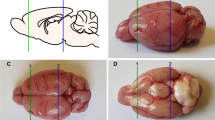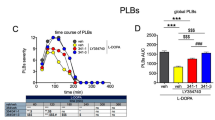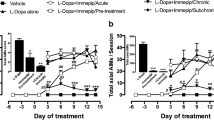Summary
The competitive NMDA-antagonists SDZ EAA-494 and CGP 37849 and the mixed D-1/D-2 dopamine agonists CI 201-678 and SDZ 205-152 reverse akinesia in monoamine-depleted mice in a dose dependent manner. Combination of threshold doses of NMDA-antagonists with dopamine agonists markedly enhances anti-akinetic effects. CI 201-678 which in addition to D-1 and D-2 receptors stimulates α-2 receptors produces a stronger effect than SDZ 205-152 which is devoid of α-2 agonist activity. The results indicate that concomitant blockade of NMDA-receptors and activation of dopamine receptors results in synergistic or at least additive motor stimulatory effects.
Similar content being viewed by others
References
Aebischer B, Frey P, Haerter HP, Herrling PL, Mueller W, Olverman HJ, Watkins JC (1989) Synthesis and NMDA antagonistic properties of the enantiomers of 4-(3-phos-phonopropyl)piperazine-2-carboxylic acid (CPP) and of the unsaturated analogue (E)-4-(3-phosphonoprop-2-enyl)piperazine-2-carboxylic acid (CPP-ene). Helv Chim Acta 72: 1043–1051
Bjoerklund A, Lindvall O (1984) Dopamine containing systems in the CNS. In: Bjoerklund A, Hoekfelt T (eds) Handbook of chemical neuroanatomy, vol 2. Classical transmitters in the CNS, part I. Elsevier Science, Amsterdam, pp 55–122
Carlsson M, Carlsson A (1989 a) The NMDA antagonist MK-801 causes marked locomotor stimulation in monoamine depleted mice. J Neural Transm 75: 221–226
Carlsson M, Carlsson A (1989 b) Dramatic synergism between MK-801 and clonidine with respect to locomotor stimulatory effect in monoamine-depleted mice. J Neural Transm 77: 65–71
Chiodo LA, Berger TW (1986) Interactions between dopamine and amino acid-induced excitation and inhibtion in the striatum. Brain Res 375: 198–203
Divac I, Oeberg G (1979) The neostriatum. Pergamon Press, Oxford, pp 291–313
Dykens J, Stern A, Trenkner E (1987) Mechanism of kainate toxicity to cerebellar neurons in vitro is analogous to reperfusion tissue injury. J Neurochem 49: 1222–1228
Fagg GE, Olpe HR, Pozza MF, Baud J, Steinmann M, Schmutz M, Portet C, Baumann P, Thedinga K, Bittiger H, Allgeier H, Heckendorn R, Angst C, Brunish D, Dingwall JG (1990) CGP 37849 and CGP 39551: novel and potent competitive N-methyl-D-aspartate receptor antagonists with oral activity. Br J Pharmacol 99: 791–797
Fonnum F (1984) Glutamate: a neurotransmitter in mammalian brain. J Neurochem 42: 1–11
Freund TF, Powell JF, Smith AD (1984) Tyrosine hydroxylase-immunoreactive boutons in synaptic contact with identified striatonigral neurons, with particular reference to dendritic spines. Neuroscience 13: 1189–1215
Giger RKA, Jaton AL, Closse A, Markstein R, Vigouret JM (1986) New abeorphine derivatives functionalized at C-4: total synthesis and biological activity. IXth International Symposium on Medicinal Chemistry, Berlin, September 14–18
Gunilla R, Oeberg E, Divac I (1981) Levels of motor planning. Cognition and the control of movement. TINS 4: 122–124
Jaton AL, Giger RK, Vigouret JM, Enz A, Frick W, Closse A, Markstein R (1986) Pharmacological profile of the abeorphine 201–678, a potent orally active and long lasting dopamine agonist. Life Sci 38: 155–163
Johnson SW, Palmer MR, Freedman R (1983) Effects of dopamine on spontaneous and evoked activity of caudate neurons. Neuropharmacology 22: 843–851
Markstein R, Jaton AL, Vigouret JM, Giger R, Closse A, Briner V, Enz A (1984) Pharmacological properties of 201–678 a new dopamine agonist. Clin Neuropharmacol 7 [Suppl 1]: 800–801
Marsden CD (1982) The mysterious motor function of the basal ganglia: the Robert Wartenberg lecture. Neurology 32: 514–539
Monaghan DT, Cotman CW (1985) Distribution of N-methyl-D-aspartate-sensitive L-[3 H]glutamate-binding sites in rat brain. J Neurosci 5: 2909–2919
Monaghan DT, Bridges RJ, Cotman CW (1989) The excitatory amino acid receptors: their classes, pharmacology, and distinct properties in the function of the central nervous system. Annu Rev Pharmacol Toxicol 29: 365–402
Schmidt WJ (1986) Intrastriatal injection of d,1-2-amino-5-phosphonovaleric acid (AP-5) induces sniffing that is antagonized by haloperidol and clozapine. Psychopharmacology 90: 123–130
Watkins JC (1989) The NMDA receptor concept: origins and development. In: Watkins JC, Collinridge GL (eds) The NMDA-receptor. Oxford University Press, Oxford, pp 1–17
Author information
Authors and Affiliations
Rights and permissions
About this article
Cite this article
Kannari, K., Markstein, R. Dopamine agonists potentiate antiakinetic effects of competitive NMDA-antagonists in monoamine-depleted mice. J. Neural Transmission 84, 211–220 (1991). https://doi.org/10.1007/BF01244971
Received:
Accepted:
Issue Date:
DOI: https://doi.org/10.1007/BF01244971




